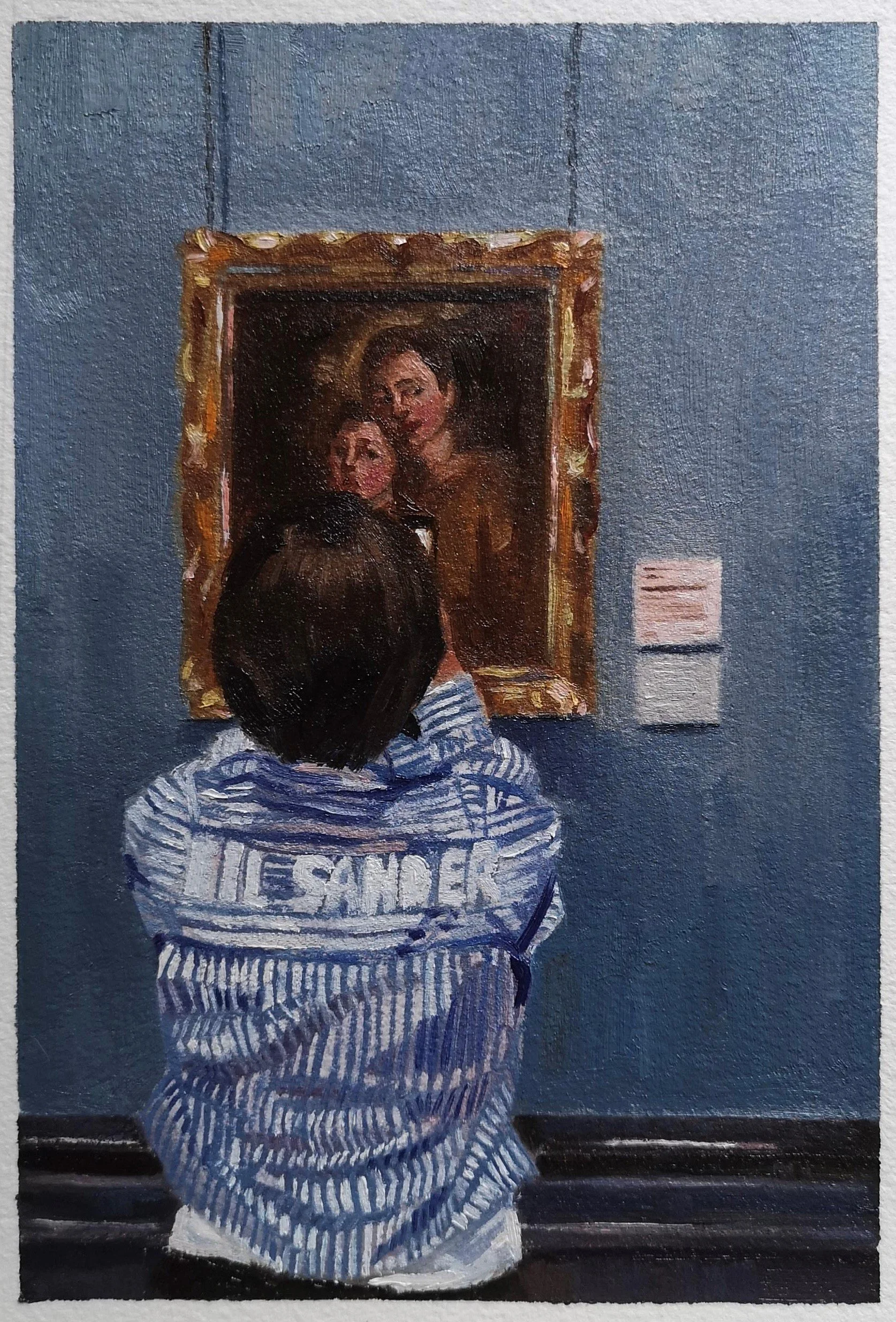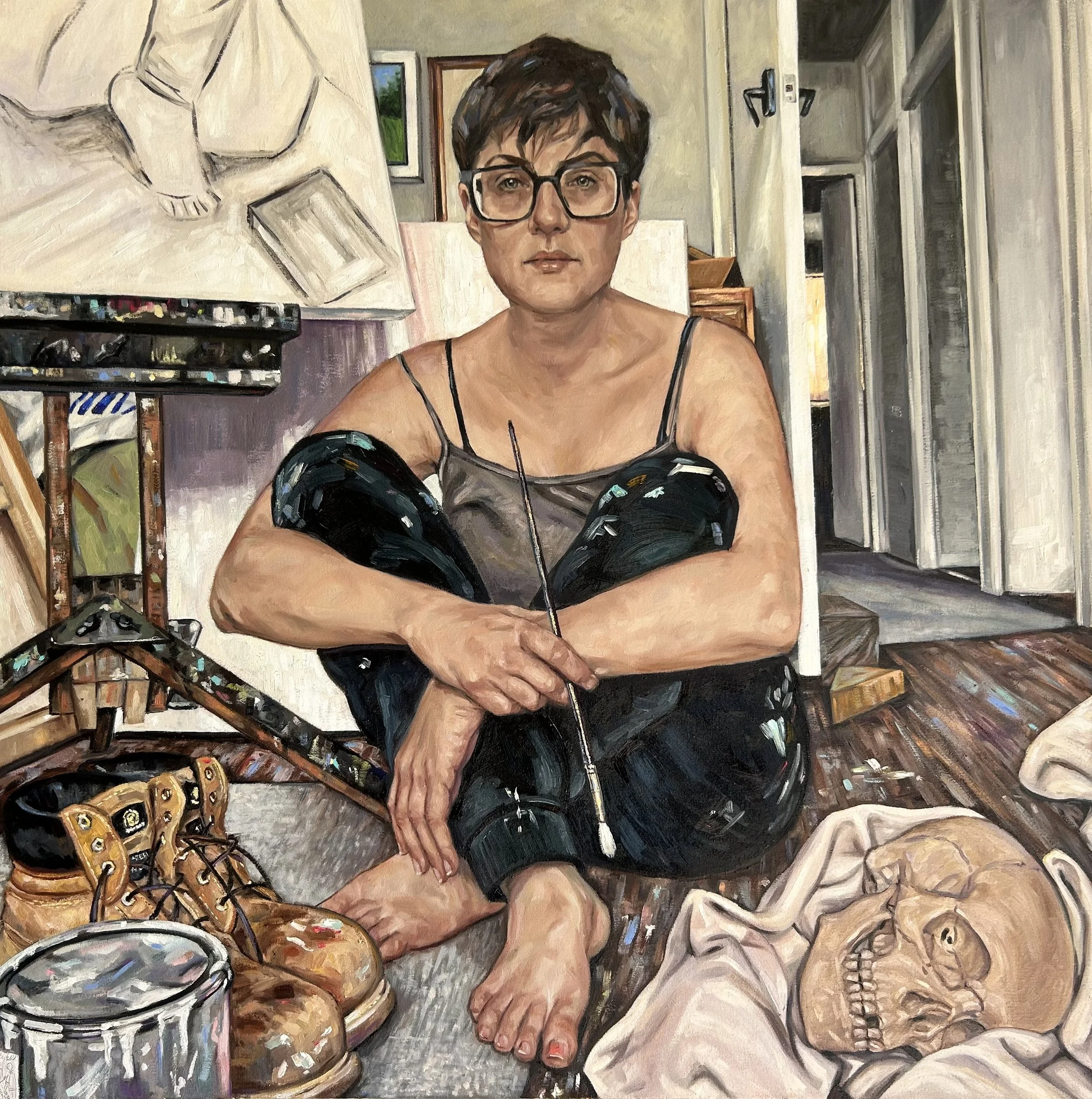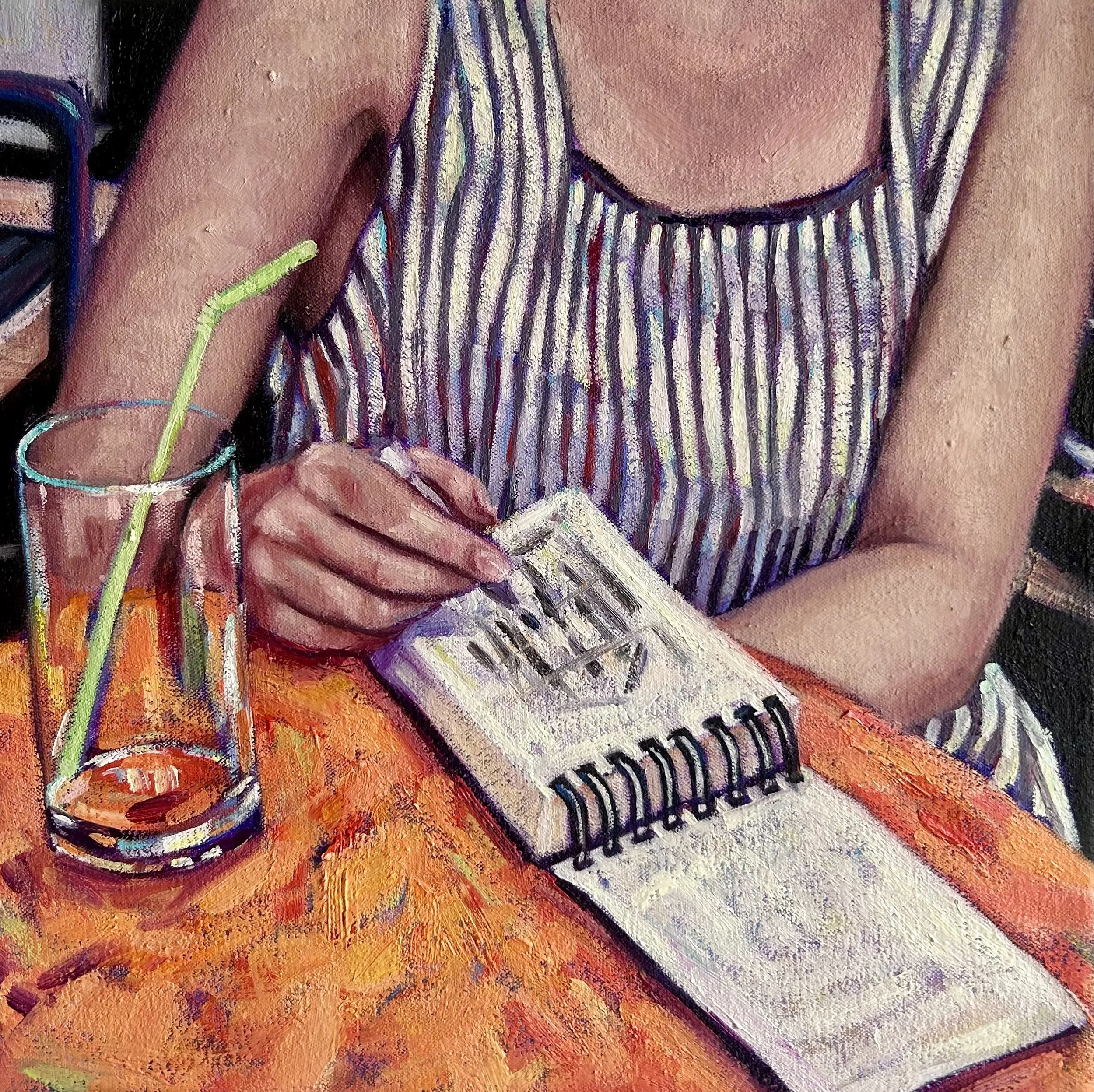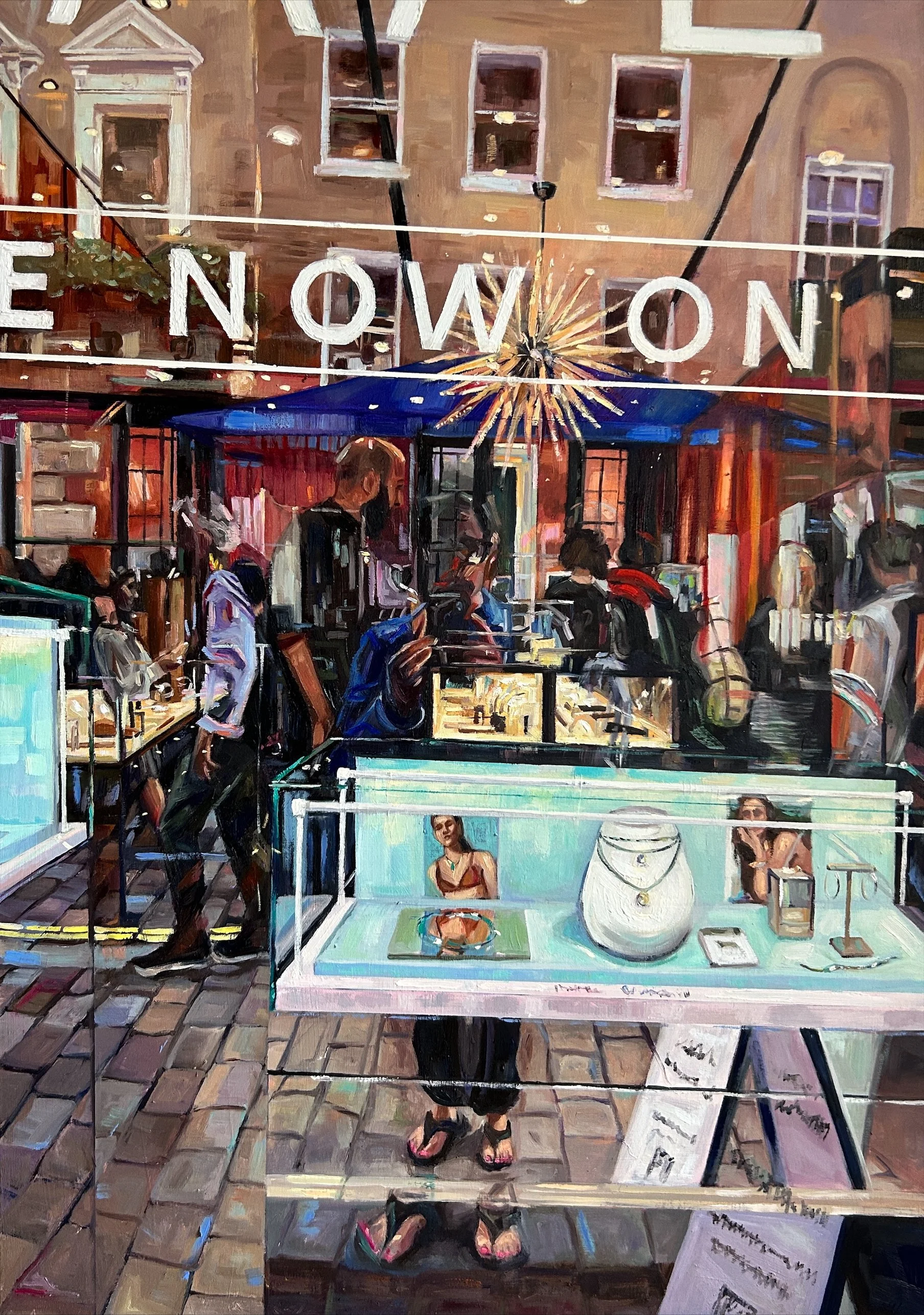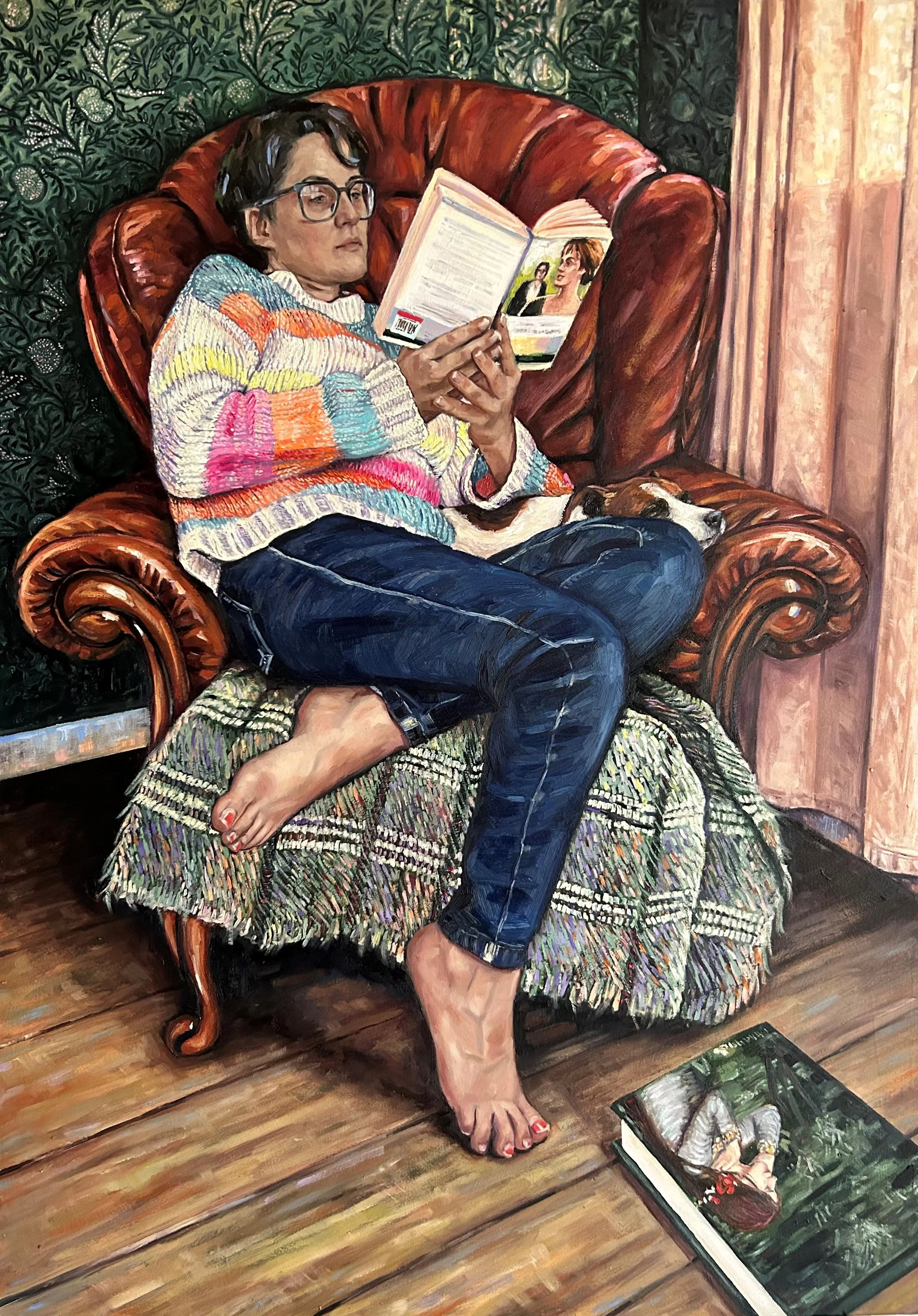ARTIST INTERVIEW: HANNAH BROADHEAD
Hannah Broadhead
In your biography, you state how your first sentence as a child was ‘Pen and paper please.’ How has your upbringing been influential to your artwork? Why are you so drawn to paint?
It was, so my sister and myself were always drawing, we were never outgoing children, I think early on it was clear that it was something that we enjoyed and we were good at, and as a child when you are the kids that get to paint the windows at primary school instead of being in class, you wanted to keep doing it. My father’s dad was a caricaturist in the war magazines, he died before we ever got to meet him but my nan would show us his drawings of Fred Astaire that he was drawing on his deathbed and share all these old Hollywood magazines surrounding us with these beautiful faces, so my love of portraits was there from a young age. I want to be still creating on my deathbed. The most influential moment though was my mom took us to see the Pre Raphaelites at Birmingham and it had Millais Ophelia on show, and I remember being 10 or 11 and just falling in love with this women who was so far removed. It was not to long after I started to teach myself to paint in oils. My mom knew the importance of art and from that day I knew I wanted to be someone who had work on the walls of a gallery.
Paint is so exciting; a brush mark can change everything.
‘The Artist’
Thinking about your last piece, what ignited your imagination to create it?
So, I have a number of ideas that run side by side, I have studio pieces and then I have outside pieces, and my last painting was one of these outsider paintings; ‘Window shopping’. It is a self portrait but instead of being the main protagonist, I rendered myself into marks in the reflection of a London Street in parts transparent. It’s a painting about everything else, life that is happening. It looks at the ideas of how outside the studio I become insignificant, I become lost in that environment, this is further exaggerated by the notion that I am standing taking a selfie of a reflection of myself in a window that is not actually a true representation. These reflective pieces also give me a chance to combine all three genres, landscape, portrait and still life.
‘Window Shopping’
Just over 5 years ago you became a full-time artist, what impact has this had on you and your work? Describe a day in the life as an artist!
I became a full-time artist just before lockdown, the timing worked really well. I went out and painted local scenes and made prints from home and started selling those. Going full time is hard, its something that is constantly worked on, I see a lot of artists try to do it and fail because they will only do what they want to do. I think early on I realised that I was not going to be able to afford to paint anything I wanted, I had to work to my strengths, I did paintings of Hollywood icons, if someone wanted a restaurant sign i’d paint it, I’ve painted cupboard doors, I never refused a job. As I have found my feet, I can now have the freedom to turn down something if it doesn’t feel right. Once lockdown ceased I was able to set up and run a weekly classes and this is something that now it’s become established, gives me time to focus on my own personal work without relying on selling a painting. Who wakes up in a morning and says I’m going to buy a painting and that is such a wake-up call? However, it is nice when it happens.
A day in the life of an artist, starts of by a walk with my Studio Assistant Button, a jack Russell who runs the household, then it working on whatever is on the easel, with an audiobook or podcast on. If I’m working on my personal work, I’ve started making my own canvas panels, and I experiment with techniques, and ideas for new work. I try to manage about 7 hours a day of actual painting or drawing. Some days are lost on the computer or making arrangements for classes, workshops demos. I rely on a to do list for the week. Most nights I dream about paint or if I’m having problems with my paintings and when that happens, I have to try it, I resolve a lot of paint issues in my sleep.
‘A New Way of Looking’
Your baggy jumpers and good reads/studio breaks series features yourself as the subject. Do you find it more, or less challenging to paint yourself, rather than a sitter? Why was it important to the narrative to have yourself as the subject?
I’d describe myself as a prolific self portrait-or. The reason being is that as an artist there is an element of self absorbance, not in an arrogant way, for me in a way I know myself inside and out, there is this duality I know how I want to portray an idea and its easier to use myself, there’s no waiting for the right time to take pictures or set up, I can get the idea out quickly without overthinking. But once I have an idea and start to paint, I remove myself and refer to myself as her or she/sitter. I think I say more using myself as the sitter, the work I do of myself, the narratives revolve around my mental health struggles something I fight everyday, this is where again duality comes into my work on the surface it can look like just a painting of me in a studio, but there are things placed that are off kilter and leaning on to darker thoughts, I tend to add hints in the forms of various pictures that I surround myself with on the walls and how my hands are holding things and how I use my body. I drop the happy mask when I paint, me I paint feelings. Depression is self absorbing; it’s like being in a space and only you are the one in it. In my studio I am the only one in, there is a freedom to using myself as a model.
‘The Inbetween’
If I do use sitters, I tend to choose sitters who are the opposite of me in appearance, and have ideas just for them. I think with sitters there’s more of reliance on getting a likeness. I like to also use sitters as a way of showing disconnect between the viewer, and create narratives I can control, I want to give them a story that I can use to heighten the painting and feelings.
I’m also a cheap model.
My baggy jumpers and good reads take me away into a space and that is comforting that for a few hours. I can disappear to somewhere else.
A book that features heavily in your baggy jumpers and good reads series is Jane Austen’s ‘Pride & Prejudice’. Why is this book significant to you and your work?
Books always have been a big part of my life, Pride and Prejudice is like a comfort blanket; it never disappoints. I thrive for happy endings ,when used in conjunction with Peter Trippi JW Waterhouse book in my painting ‘A Tale of Two Different Endings’, in my hands I’m embracing Jane Austen one of the greatest love stories put to paper, at my feet Ophelia, one of the most tragic love stories appear on the front cover. I’m constantly making things slightly of kilter.
‘A Tale of Two Endings’
I have certain indicators that appear to link my work together, Delaroche’s Lady Jane Grey appears, Ophelia, Pandora, Lizzie Bennett, they share these moments in time where as a women I’ve related to. I like the continuity of these tales, each studio painting there is a link to a previous painting, that means my paintings narrative doesn’t end with one painting, it’s a story I keep telling, my work is like a book; each page is one of my paintings.
Describe your process from start to finish of a painting. What is your favourite part of the process, and why?
My process changes depending on the surface, panel works well for reflection paintings the paint glides, self portraits are on handmade panels when I want to build up layers. I love to experiment with paintings, so I do constantly try new ways of painting.
There was a time when first started out as full-time artist I relied heavily on gridding and when my confidence started to grow, I re-trained my brain to trust myself and paint without grids. However, I have recently started to use a loose grid when doing larger pieces just to get positioning. For example, if its 90cm by 90cm, I use a 9 square grid on it so it doesn’t stifle my painting freedom. Its so easy to fall in the trap of sticking to it and it taking over.
I tend to use a graphite and turps wash then add the paint. I try not to use too much medium. I like the effect of pure oil paint; it works well for colour laying. I use a lot of colour theory so I will put a pop of red let it settle then use the final colour green on top to push colours forward. This does mean that I leave paintings in between colour layers to settle before adding final layers over night or for a couple of days. It’s a process that brings luminosity to my work.
My favourite part is the initial getting everything just positioned right, then laying colours down. The part I hate most is varnishing. I dread it; its so easy to get it wrong.
‘Balancing Act’
In 2023, you were a contestant on Sky Arts Portrait Artist of The Year. Describe this experience. Did you find any parts of it challenging?
It’s a privilege, but it takes a lot out of you mentally and physically. You have approx. 4/5 weeks to prep, then when you are there, it never prepares you, as adrenaline takes over and you are painting like crazy in a way you didn’t know you could. Then when it ends you have to recover from this, which is hard as it can feel like when you don’t make it through, it can feel like a rejection and slight panic of oh no what am I going to look like or sound like. You question yourself a lot, I should have said this or done this.
I think you are expected to create a painting that exceeds your submission and that is so difficult as you are in this alien environment, you are unable to achieve the same level as in studio, for me it was definitely this way.
You have to put things into context. It’s this amazing day, you have incredible highs when audience members tell you how much they enjoy watching you, you have incredible lows, but what it does do is make you realise you are not this imposter if you have been picked out of thousands. Its such a confidence boost when you see through all the craziness of the day.
I talked a lot to the audience, and when I got home had a commission from one of the audience members and people joined my classes, the crew are the heart of the show they are so supportive they are what makes it.
In Sky PAOTY, your sitter was Shirley Ballas. How did you establish the composition? As you were painting a celebrity, do you think that you had a pre-conception of her which influenced your painting? How did you capture her personality in your painting?
So I usually work from photos, but I decided I was going to paint from life, and looking back I should have used an iPad, as in reality you have about 2 and half to 3hours to paint, as interviews from presenters and crew take up the majority. I knew before I went, I was going to focus on just a head portrait due to the time scale, what I didn’t counter in was the fact that Shirley subconsciously moved when ever the camera came near, I was constantly shouting for her attention. Hence why I painted her with the side eye. However, she was beautiful, I had a joke with Steve Mangham before I started, he said what did you want in a sitter, I said someone natural looking as I’m a dirty painter, and I mean I don’t clean brushes between colour changes on portraits, he chuckled to himself. He was great fun! Then Shirley comes out looking like a film star.
If you could spend a day with any artist; dead or alive, who would it be, and why?
There are so many I love. Paula Rego, her story telling is sublime, its such a hard question as I would pick things from different artists to create the ultimate artist, so I’m going to be cheeky and create the ultimate.
Paula Rego for her story telling, Van Gogh for his way of seeing himself, Frida Kahlo for pure emotion, I have to include Burne-Jones for his pure escapism and being local artist and one I was brought up on, Tracy Emin for her confidence and know her self-worth, Maggie Hambling for not caring.
Why do you think art is important in society?
Art is so important it can take you away, if you let it too somewhere else, be someone else. A moment in history, its social commentary. A painting, sculpture it talks to you on so many levels. In the same way people say I remember where I was when I heard this song. I can tell you the first painting that I cried in front of, the first time I saw myself in a portrait, the feeling of being elated by seeing brush marks on the surface. Standing in front of a sculpture and feeling completely overwhelmed, great art moves you and becomes part of your being.

